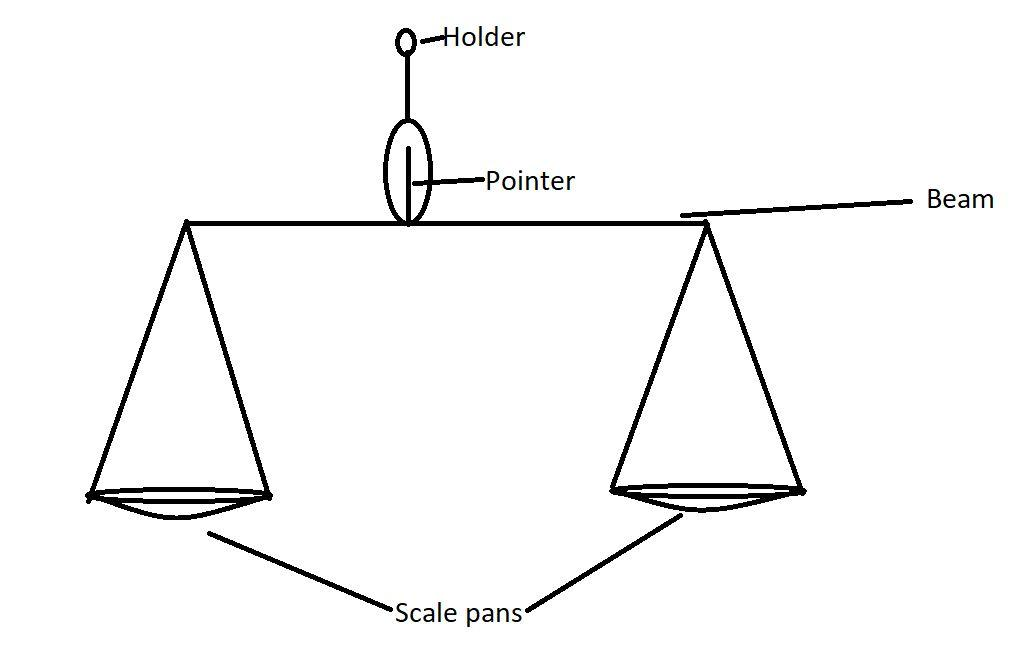
A physical balance works on the principle of:
A. Moments
B. Circular motion
C. Both
D. None
Answer
588.3k+ views
Hint: The Principle of Moments states that when a body is balanced at a point d, the total clockwise moment and the total anticlockwise moment about the point d equals to zero. That is the clockwise and anticlockwise moment are canceling each other.
Complete answer:
A physical balance is something that is used to compare the weight of two different objects. It is generally used by vegetable sellers and gold shops. We can say that physical balance is a device that is used to measure the mass and weight of a body. The value measured can be corrected to a milligram.

The physical balance consists of many parts such as the holder to hold the balance properly, the pointer which indicates on which side the weight is more, the scale pans where the weights to be measured are placed, and the beam with which the scale pans are attached with the help of the string. Now if we see a physical balance we will see that it is pivoted at a fixed point and the balance can fall on one side at a time which means that it has the same principle as the principle of moments hence.
A physical balance works on the principle of moments.
So, the correct answer is “Option A”.
Additional Information:
In the principle of moments clockwise moments are considered negative when they are summed with anticlockwise moments because the moments are acting opposite to each other and also anticlockwise moments are positive because when they act upon an object, they move the object upwards on the Y-Axis.
The turning moment is calculated with respect to the distance and the force applied from the point about which turning movement is to take place. So now we know that both force and distance can be zero or positive also but it is not ideally possible for any of the parameters to become negative. So the moment can never be negative but they can be equals to zero.
Note:
To calculate the principle of moments, we have the formula as (moment or torque = force $\times $ perpendicular distance from the pivot d. In principle of moments, anticlockwise moments are considered as positive and clockwise moments are considered negative).
Complete answer:
A physical balance is something that is used to compare the weight of two different objects. It is generally used by vegetable sellers and gold shops. We can say that physical balance is a device that is used to measure the mass and weight of a body. The value measured can be corrected to a milligram.

The physical balance consists of many parts such as the holder to hold the balance properly, the pointer which indicates on which side the weight is more, the scale pans where the weights to be measured are placed, and the beam with which the scale pans are attached with the help of the string. Now if we see a physical balance we will see that it is pivoted at a fixed point and the balance can fall on one side at a time which means that it has the same principle as the principle of moments hence.
A physical balance works on the principle of moments.
So, the correct answer is “Option A”.
Additional Information:
In the principle of moments clockwise moments are considered negative when they are summed with anticlockwise moments because the moments are acting opposite to each other and also anticlockwise moments are positive because when they act upon an object, they move the object upwards on the Y-Axis.
The turning moment is calculated with respect to the distance and the force applied from the point about which turning movement is to take place. So now we know that both force and distance can be zero or positive also but it is not ideally possible for any of the parameters to become negative. So the moment can never be negative but they can be equals to zero.
Note:
To calculate the principle of moments, we have the formula as (moment or torque = force $\times $ perpendicular distance from the pivot d. In principle of moments, anticlockwise moments are considered as positive and clockwise moments are considered negative).
Recently Updated Pages
Questions & Answers - Ask your doubts

Master Class 9 Social Science: Engaging Questions & Answers for Success

Class 9 Question and Answer - Your Ultimate Solutions Guide

Master Class 8 Science: Engaging Questions & Answers for Success

Master Class 9 General Knowledge: Engaging Questions & Answers for Success

Master Class 9 English: Engaging Questions & Answers for Success

Trending doubts
One Metric ton is equal to kg A 10000 B 1000 C 100 class 11 physics CBSE

Discuss the various forms of bacteria class 11 biology CBSE

Explain zero factorial class 11 maths CBSE

What is 1s 2s 2p 3s 3p class 11 chemistry CBSE

State the laws of reflection of light

Difference Between Prokaryotic Cells and Eukaryotic Cells




